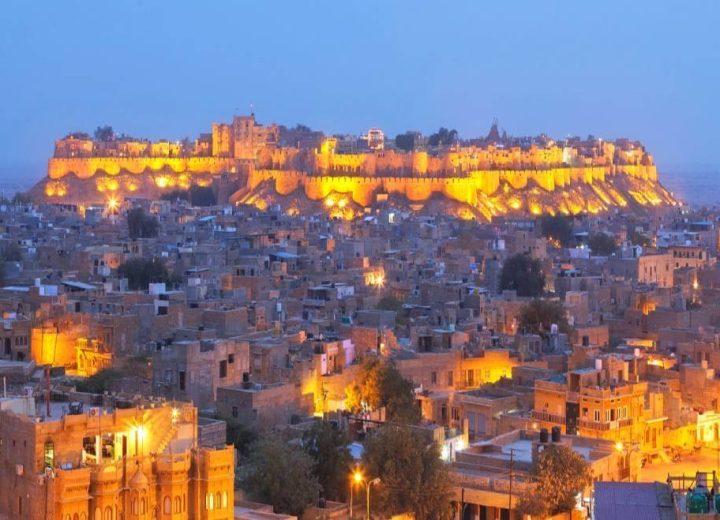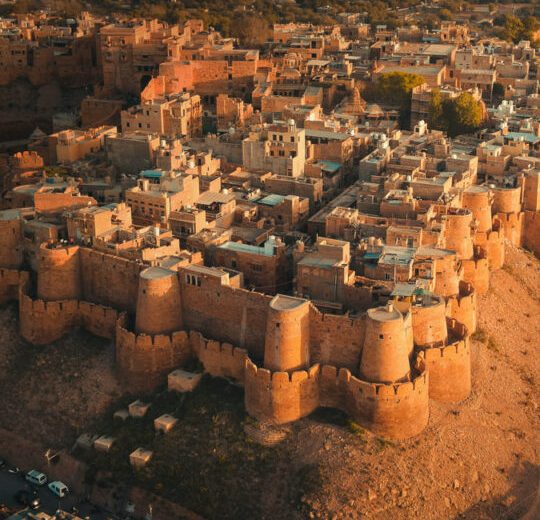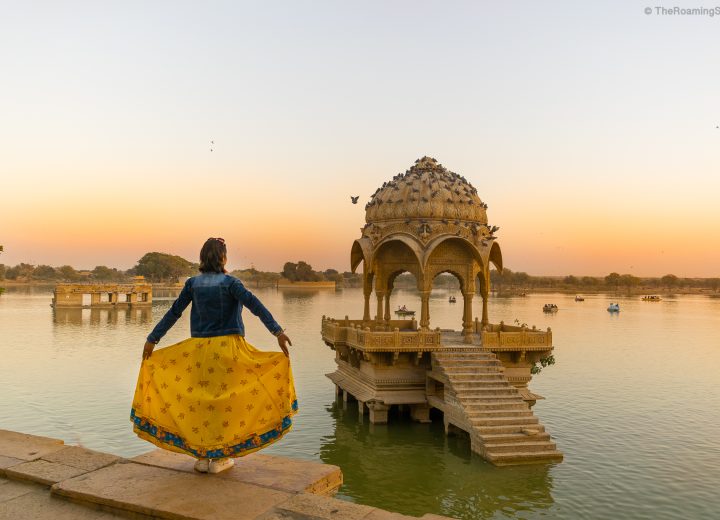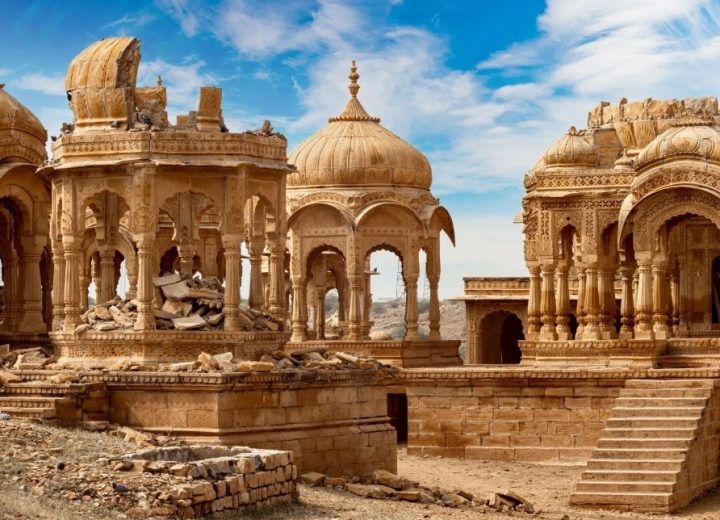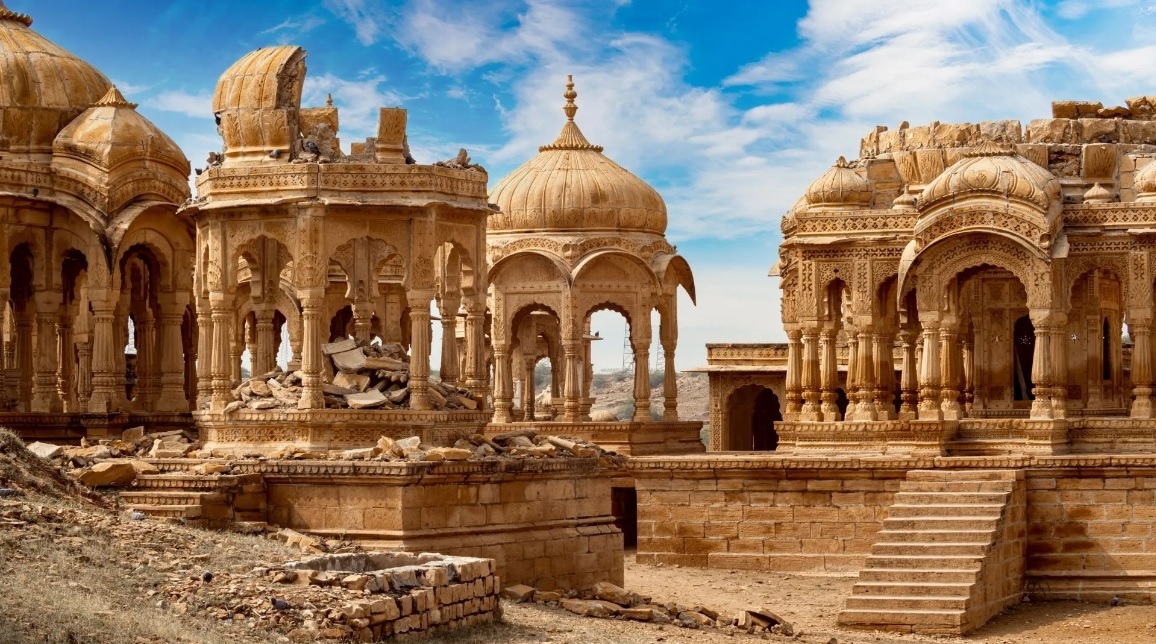
Jaisalmer Travel Guide: Visiting The Jewel Of India’s Thar Desert
In the remote westernmost corner of Rajasthan, Jaisalmer is the quintessential desert town, its golden, sand-coloured ramparts rising out of the arid Thar like a scene from the Arabian Nights. Rampant commercialism may have dampened the romantic vision somewhat, but even with all the touts and tour buses, the town deservedly remains one of India’s most popular destinations. Villagers dressed in voluminous red and orange turbans still outnumber foreigners in the bazaar, while the exquisite sandstone architecture of the “Golden City” is quite unlike anything else in India.
Jaisalmer Travel Essentials
Weather: 28° C
Ideal duration: 2-3 days
Best Time: Oct-Mar
“The Golden City”
Jaisalmer Tourism
The Jaisalmer Fort stands as a citadel with narrow alleys inhabited by people for generations and shops selling colourful handicrafts.
Jaisalmer is a town, and to reach the Sand Dunes, travellers have to take a jeep safari followed by a camel ride. Thus, Jaisalmer is an amalgamation of exotic Indian desert culture, heritage and adventure.
Jaisalmer Travel Packages
Compare quotes from upto 3 travel agents for free
The best travel tips for visiting Jaisalmer
The streets of Jaisalmer are flanked with numerous, pale honey-coloured facades, covered with latticework and floral designs. However, the city’s real showpieces are its havelis (traditional townhouse), commissioned by wealthy merchants during the eighteenth and nineteenth centuries.
In addition, there are numerous sights out of town, as well as the desert itself – camel safaris are an extremely popular activity here. Most travellers will take the chance to spend at least one night out in the sands.
Rough Guides tip: Planning a trip to India? Perhaps our local experts in India can help you!

Jaisalmer Fort © Shutterstock
Best things to do in Jaisalmer
From Jaisalmer Fort to the Desert Cultural Centre & Folklore Museum, here are the best things to do in Jaisalmer.
#1 Don’t miss Jaisalmer Fort
Every part of Jaisalmer Fort is made of soft yellow Jurassic sandstone. Outside, the thick walls, punctuated with barrel-sided bastions, drop almost 100m to the town below, while inside narrow winding streets are flanked with carved golden facades.
Two thousand people still live within its walls; seventy percent of them are Brahmins and the rest, living primarily on the east side, are predominantly Rajput.
A paved road punctuated by four huge gateways winds up to the fort’s main chowk (square) – large round stones lie atop the ramparts above the entrance, waiting to be pushed down on the heads of any approaching enemy.
The main chowk was the scene of the three terrible acts of johar during the fourteenth and fifteenth centuries, when the women of the royal palace, which overlooks the chowk, had a huge fire built, and jumped from the palace walls into it.
#2 Admire some of the finest masonry in Jaisalmer at the Fort Palace Museum
The chowk is dominated by the Palace of the Maharawal, open to the public as the Fort Palace Museum. The palace’s balconied, five-storey facade displays some of the finest masonry in Jaisalmer, while the ornate marble throne to the left of the palace entrance is where the monarch (known in Jaisalmer as the maharawal rather than the maharaja) would have addressed his troops.
Inside, the museum offers an intriguing snapshot of the life of Jaisalmer’s potentates through the ages, with artefacts ranging from a fancy silver coronation throne to more homely items, such as the bed and thali dish of a nineteenth-century ruler. There’s also an interesting array of other exhibits – from fifteenth-century sculptures (including an unusual bearded Rama) through to local stamps and banknotes, while the rooftop terrace gives unrivalled views over the city and the surrounding countryside.
#3 Head to the impressive Jain temples
The fort has a number of Hindu temples, including the venerable Laxminath Temple of 1494; however, none is as impressive as the complex of seven Jain temples.
The temples, connected by small corridors and stairways, were built between the twelfth and fifteenth centuries with yellow and white marble shrines and exquisite sculpted motifs covering the walls, ceilings and pillars.
Two of the seven temples are open between 8am and noon; the other five only open from 11am to noon, when the whole place gets overrun with coach parties, so it’s best to visit before 11am to see the first two temples, then come back later to see the rest.

Roof of the Jain temple in Jaisalmer, India © Shutterstock
#4 Explore the old town
Jaisalmer’s captivating old town surrounds the fort, and contains a few sights of its own, not least a series of delightful havelis. Despite the area’s slightly labyrinthine layout, most tourists end up navigating precisely the same channels – as such, it’s surprisingly easy to step away from the souvenir stand hawkers, and end up in a little slice of “real” Jaisalmer.
#5 Get a taste of the city at the Thar Heritage Museum
In the centre of town, the modest little Thar Heritage Museum is one of Jaisalmer’s more interesting museums.
Showcasing the personal collection of a local historian, who may be on hand to explain some of the stories and customs behind the quirky array of local artefacts on display, exhibits range from bits of fossilised tree and old chillums through to camel regalia and antique musical instruments.
#6 Check out the architecture of Nathmalji-ki-Haveli
Just north of Bhatia Bazaar, the Nathmalji-ki-Haveli was built in 1885 for Jaisalmer’s prime minister by two brother stonemasons, one of whom built the left half, the other the right, as a result of which the two sides are subtly different.
It’s guarded by two elephants, and the first-floor bay window above the main doorway is surmounted by a frieze of little figures including elephants, horses, a steam train and a horse-drawn carriage. The place is basically a shop now, but it’s still worth a look.
#7 Head to Patwa Haveli to see its exuberantly carved jharokhas
The finely decorated Patwa Haveli, or Patwon-ki-Haveli, lies a couple of blocks north of the Nathmalji-ki-Haveli, its exterior a positive riot of exuberantly carved jharokhas (protruding balconies).
The haveli was constructed in the first half of the nineteenth century by the Patwa merchants – five brothers from a Jain family who were bankers and traders in brocade and opium.
There are actually five separate suites within the haveli; two are closed to visitors and two more, preserved in their original condition, are open as government museums.
One, the Kothari Patwa Haveli Museum, has various traditional artefacts on display and replica mirrorwork on the walls, giving you some idea of how the haveli would originally have looked.
As well as visiting the interior of the Patwa Haveli, it’s worth taking a little stroll down the street whose entrance it bridges, to check out the stonework on four impressive neighbouring havelis.
#8 Stand in awe of the lavishly carved overhanging rooftop balcony of Salim Singh ki Haveli
The third of Jaisalmer’s famous trio of havelis, the Salim Singh ki Haveli, lies on the east side of town and is immediately recognisable by the lavishly carved overhanging rooftop balcony that gives the whole building a strangely top-heavy appearance.
Its upper floor, enclosed by an overhanging balcony, is best seen from the roof of Natraj restaurant. Halfway up the building is a surprisingly good shop, with ornate pots and traditional “air fresheners” in the shape of animals, which use natural oils.

Salim Singh ki Haveli, Jaisalmer © Shutterstock
#9 Watch the sun rise or set at Gadi Sagar Tank
South of the old town, through an imposing triple gateway, lies Gadi Sagar Tank, once Jaisalmer’s sole water supply. Now flanked with sandstone ghats and temples, it’s a peaceful place, staring out into the desert, and a good spot for watching the sun rise or set. You can also rent boats here for a spin on the water.
#10 Find some local curiosities at the Desert Cultural Centre & Folklore Museum
Local curiosities including musical instruments, fossils, tools, utensils and rare manuscripts are on display at the Desert Cultural Centre & Museum, next to the tourist office on the main road.
The main exhibit is a cloth painting depicting the life of the local folk hero Pabuji, a legendary figure credited with introducing the camel to Rajasthan; the museum also recently absorbed various exhibits from the Folklore Museum, once located by the main gate of the Gadi Sagar Tank, including folk art and textiles, along with opium and betel nut paraphernalia.
Of more interest to most visitors, however, are the puppet shows hosted each evening, with English narration.

Haveli, Jaisalmer, Rajasthan © Shutterstock
Best areas to stay in Jaisalmer
Jaisalmer has plenty of accommodation, and fierce competition keeps prices low. Most places offer free pick-up from the bus or railway stations, and the majority offer camel treks, which vary in standard and price.
There are a number of newer places outside the fort, many of which are built in traditional sandstone and come with superb fort views. The basic choice is between one of the old places within the wonderfully atmospheric fort – but Jaisalmer is also in jeopardy.
Browse the best hotels in Jaisalmer.
Word of warning: Jaisalmer is in jeopardy
Erected on a base of soft bentonite clay, sand and sandstone, the foundations of Jaisalmer Fort have been eroding in recent decades. This is due to huge increases in water consumption, mainly related to tourism.
At the height of the season, around 120 litres per head are pumped into the area. However, due to problems with the drainage system, a large proportion of this water seeps back into the soil beneath the fort, weakening its foundations. The results have been disastrous. In 1998 six people died when an exterior wall gave way, and five more bastions fell in 2000 and 2001.
Jaisalmer’s fort has been listed among the World Monument Fund’s most endangered sites. An international campaign was set up to facilitate repairs throughout the fort, including assistance with upgrading underground sewerage. Despite the work so far carried out, however, some continue to think that the best way to save the fort would be to evacuate its two thousand inhabitants and start repairs to the drainage system from scratch. That expensive and time-consuming venture is much opposed by the guesthouse owners inside, whose earnings depend on tourism.
Given all this, some people (and guidebooks) suggest that travellers should avoid staying in the fort in order to relieve pressure on its crumbling foundations. Unfortunately, this also has a serious side effect in that it deprives many local hoteliers – some of whom have been in the fort for decades – of a living. If you do stay in the fort, you can do your bit by minimising your water usage as much as possible.
Best restaurants and bars

Gadi Sagar Tank in Jaisalmer © Shutterstock
How to get around
You’ll mainly only need to walk around Jaisalmer but there are ways to get around as well.
Auto-rickshaws are a popular and convenient mode of transport within the city as you’ll only be wlaking inside the walls. Agree on a fare before starting your journey. Taxis are available across Jaisalmer. It’s advisable to use prepaid taxi services.
What is the best time to visit Jaisalmer?
The best time to visit Jaisalmer is during the pleasant winter months from November to February. At this time, temperatures range from around 24°C (75°F) during the day to 7°C (45°F) at night. This period allows for an enjoyable exploration of popular landmarks without the scorching heat of summer.
Winter is also the peak tourist season, offering a lively atmosphere and events like the Desert Festival in February, which showcases Rajasthan’s rich heritage. We still recommend you pack warm clothing for chilly mornings and evenings in December and January.
Find out more about the best time to visit India.

Jaisalmer Fort © Shutterstock
How many days do you need in Jaisalmer?
Most travellers will only need two or three days in Jaisalmer. That’s enough time to explore Jaisalmer Fort and wander through its historic streets in the morning. In the afternoon, you can admire intricate havelis like Patwon Ki Haveli. On day two you can take a camel safari to the Sam Sand Dunes and consider camping out overnight.
Rough Guides tip: Planning a trip to India? Perhaps our local experts in India can help you!
How to get here
By plane
Jaisalmer Airport, 14 km west of town was reopened to passenger services in 2017. However, it’s still mainly a military airport, and flights can get cancelled at short notice.
By bus
Most government buses depart from the Government Bus Stand east of town on Barmer Rd. However, early morning departures leave from the more conveniently located State Bus Stand at the southern end of Amar Sagar Rd.
Source:
https://www.roughguides.com/india/rajasthan/jaisalmer-around/
